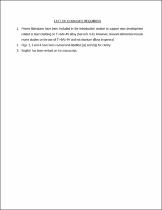 ResearchSpace
ResearchSpace
Influence of ZrB2 addition on microstructural development and microhardness of Ti-SiC clad coatings on Ti6Al4V substrate
JavaScript is disabled for your browser. Some features of this site may not work without it.
- ResearchSpace
- →
- Research Publications/Outputs
- →
- Journal Articles
- →
- View Item
| dc.contributor.author |
Farotade, GA

|
|
| dc.contributor.author |
Popoola, AP

|
|
| dc.contributor.author |
Pityana, Sisa L

|
|
| dc.date.accessioned | 2017-09-27T09:05:04Z | |
| dc.date.available | 2017-09-27T09:05:04Z | |
| dc.date.issued | 2017-08 | |
| dc.identifier.citation | Farotade, G.A., Popoola, A.P., and Pityana, S.L. 2017. Influence of ZrB2 addition on microstructural development and microhardness of Ti-SiC clad coatings on Ti6Al4V substrate. Surface review and letters: https://doi.org/10.1142/S0218625X19500057 | en_US |
| dc.identifier.issn | 0218-625X | |
| dc.identifier.uri | https://doi.org/10.1142/S0218625X19500057 | |
| dc.identifier.uri | http://www.worldscientific.com/doi/abs/10.1142/S0218625X19500057 | |
| dc.identifier.uri | http://hdl.handle.net/10204/9605 | |
| dc.description | Copyright: 2017 World Scientific. Due to copyright restrictions, the attached PDF file only contains the postprint version of the published item. For access to the full text published item, please consult the publisher's website. | en_US |
| dc.description.abstract | The microstructural features and microhardness of ZrB(sub2) reinforced Ti-SiC coatings on Ti-6Al-4V substrate were studied.The deposition of these coatings was achieved via laser cladding technique. A 4.0 KW fiber delivered Nd: YAG laser was used to deposit the coatings on the titanium substrate at a laser power of 700 W and laser scan speed of 0.8 m/min. An initial Ti-SiC coating was deposited with no ZrB2 addition followed by deposition of two other coatings with the incorporation of ZrB(sub2) powder at 5% and 10% wt. The coatings were examined using scanning electron microscope (SEM) coupled with Energy dispersive spectroscopy (EDS). SEM images of Ti-SiC-ZrB(sub2) coatings revealed good metallurgical bond between the coatings and the substrate, and also, a significant increment in dendritic formation and inter-dendritic eutectics during solidification within the á-Ti matrix, exhibiting the presence of newly formed phases as the weight percentage of ZrB(sub2) increased. Back scattered electron (BSE) images also showed the dissolution effect of SiC particles, as the particle-matrix bond strength is influenced by ZrB2 addition. Furthermore, the microhardness of the Ti-SiC coating was enhanced with increasing ZrB(sub2) weight percentage. XRD analysis revealed dominant compounds formed during laser material processing. This study deepens the knowledge of possible microstructural features associated with Ti-SiC-ZrB2 cermet coatings. | en_US |
| dc.language.iso | en | en_US |
| dc.publisher | World Scientific Publications | en_US |
| dc.relation.ispartofseries | Worklist;19473 | |
| dc.subject | Ti-SiC-ZrB2 cermet coatings | en_US |
| dc.subject | Microstructure | en_US |
| dc.subject | Microhardness | en_US |
| dc.subject | Laser cladding | en_US |
| dc.subject | Ti-6Al-4V titanium alloy | en_US |
| dc.title | Influence of ZrB2 addition on microstructural development and microhardness of Ti-SiC clad coatings on Ti6Al4V substrate | en_US |
| dc.type | Article | en_US |
| dc.identifier.apacitation | Farotade, G., Popoola, A., & Pityana, S. L. (2017). Influence of ZrB2 addition on microstructural development and microhardness of Ti-SiC clad coatings on Ti6Al4V substrate. http://hdl.handle.net/10204/9605 | en_ZA |
| dc.identifier.chicagocitation | Farotade, GA, AP Popoola, and Sisa L Pityana "Influence of ZrB2 addition on microstructural development and microhardness of Ti-SiC clad coatings on Ti6Al4V substrate." (2017) http://hdl.handle.net/10204/9605 | en_ZA |
| dc.identifier.vancouvercitation | Farotade G, Popoola A, Pityana SL. Influence of ZrB2 addition on microstructural development and microhardness of Ti-SiC clad coatings on Ti6Al4V substrate. 2017; http://hdl.handle.net/10204/9605. | en_ZA |
| dc.identifier.ris | TY - Article AU - Farotade, GA AU - Popoola, AP AU - Pityana, Sisa L AB - The microstructural features and microhardness of ZrB(sub2) reinforced Ti-SiC coatings on Ti-6Al-4V substrate were studied.The deposition of these coatings was achieved via laser cladding technique. A 4.0 KW fiber delivered Nd: YAG laser was used to deposit the coatings on the titanium substrate at a laser power of 700 W and laser scan speed of 0.8 m/min. An initial Ti-SiC coating was deposited with no ZrB2 addition followed by deposition of two other coatings with the incorporation of ZrB(sub2) powder at 5% and 10% wt. The coatings were examined using scanning electron microscope (SEM) coupled with Energy dispersive spectroscopy (EDS). SEM images of Ti-SiC-ZrB(sub2) coatings revealed good metallurgical bond between the coatings and the substrate, and also, a significant increment in dendritic formation and inter-dendritic eutectics during solidification within the á-Ti matrix, exhibiting the presence of newly formed phases as the weight percentage of ZrB(sub2) increased. Back scattered electron (BSE) images also showed the dissolution effect of SiC particles, as the particle-matrix bond strength is influenced by ZrB2 addition. Furthermore, the microhardness of the Ti-SiC coating was enhanced with increasing ZrB(sub2) weight percentage. XRD analysis revealed dominant compounds formed during laser material processing. This study deepens the knowledge of possible microstructural features associated with Ti-SiC-ZrB2 cermet coatings. DA - 2017-08 DB - ResearchSpace DP - CSIR KW - Ti-SiC-ZrB2 cermet coatings KW - Microstructure KW - Microhardness KW - Laser cladding KW - Ti-6Al-4V titanium alloy LK - https://researchspace.csir.co.za PY - 2017 SM - 0218-625X T1 - Influence of ZrB2 addition on microstructural development and microhardness of Ti-SiC clad coatings on Ti6Al4V substrate TI - Influence of ZrB2 addition on microstructural development and microhardness of Ti-SiC clad coatings on Ti6Al4V substrate UR - http://hdl.handle.net/10204/9605 ER - | en_ZA |





